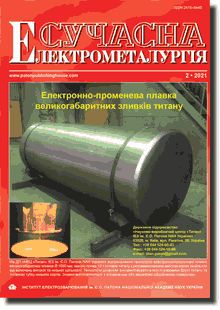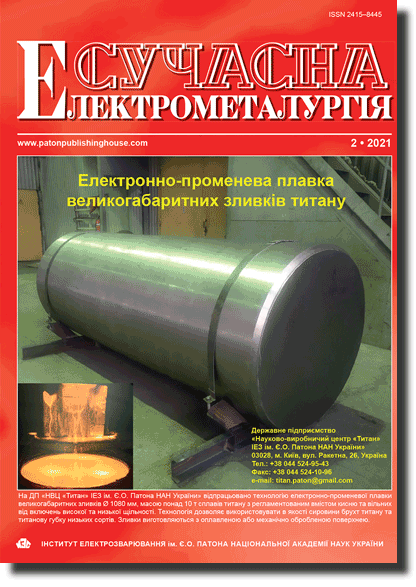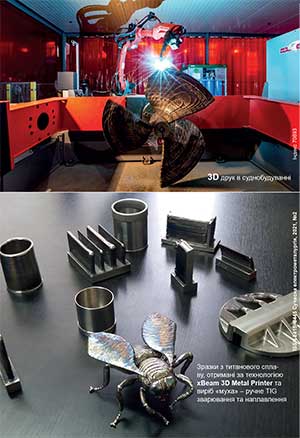| 2021 №02 (07) |
DOI of Article 10.37434/sem2021.02.01 |
2021 №02 (02) |

Сучасна електрометалургія, 2021, #2, 3-12 pages
Електрохімічні процеси при електрошлаковому переплаві (огляд)
Г.П. Стовпченко, А.В. Кадильникова
ІЕЗ ім. Є.О. Патона НАН України. 03150, м. Київ, вул. Казимира Малевича, 11. E-mail: office@paton.kiev.ua
Реферат
Еелектрошлаковий переплав є провідним процесом спеціальної електрометалургії, який використовують для отримання високоякісних сталей та сплавів. За своїми механічними (особливо пластичними) і експлуатаційними властивостями, щільністю й чистотою метал електрошлакового переплаву значно перевершує аналогічні матеріали, що вироблені способами традиційної металургії. Ступінь рафінування сталі залежить від складу і властивостей шлаку, який визначає теплову ефективність процесу та температурний режим металевої ванни, тож суттєвим чином впливає на умови затвердіння зливка та його структуру. Електроліз не є основним процесом і метою електрошлакового переплаву, тим не менш, оскільки перенесення струму в шлакових розплавах здійснюється переважно іонами, при цьому відбуваються електрохімічні реакції, які змінюють склад шлаку і металу. Проаналізовано сучасні уявлення про природу електрохімічних процесів і можливі катодні і анодні реакції в процесах ЕШП-типу на постійному струмі, в тому числі з погляду на одержання чистого за сіркою і киснем металу. Розглянуто дані щодо впливу полярності постійного струму на швидкість плавлення витратного електрода. Виявлено актуальні напрямки подальших досліджень електрохімічної сторони процесу електрошлакового переплаву для підвищення ефективності та створення нових можливостей його застосування. Бібліогр. 60, рис. 8.
Ключові слова: електрошлаковий переплав; шлак; іонний розплав; електрохімічні, катодні та анодні реакції; електрична провідність; в’язкість; полярність електрода
Received 23.06.2021
Список літератури
1. Paton, B.E., Medovar, B.I. (1981) Electroslag metal. Kiev, Naukova Dumka [in Russian].2. Medovar, B.I., Shevtsov, V.L., Marinsky, G.S. et al. (1978) Thermal processes in ESR. Ed. by B.I. Medovar. Kiev, Naukova Dumka [in Russian].
3. Latash, Yu.V., Medovar, B.I. (1970) Electroslag remelting. Moscow, Metallurgy [in Russian].
4. Nafziger, R.H. (1976) The electroslag melting process. United States Bureau of Mines, Bulletin 669, Washington.
5. Medovar, L.B., Saenko, V.Ya., Stovpchenko, A.P. et al. (2010) Electroslag technologies for producing large forging ingots. Modern electrometallurgy, 3, 5–10 [in Russian].
6. Holzgruber, V. (1977) Possibilities and limitations of the impact on the structure and properties of ESR ingots. Electroslag remelting. Kiev, Naukova Dumka, 60–75 [in Russian].
7. Mitchell, A., Bell, M. (1972) Origin of Oxide Inclusions in Ingots Made by the Electroslag Process. Canadian Met. Quart., 11(2), 363–369.
8. Mitchell, A., Jackson, R.O., Balantine, A.S. (1975) Macrosegregation, fluid motion and heat transfer in the ESR process. Electroslag remelting. Kiev, Naukova Dumka, 29–38 [in Russian].
9. Klyuev, M.M., Volkov, S.E. (1984) Electroslag remelting. Moscow, Metallurgy [in Russian].
10. Medovar, L., Petrenko, V., Sybir., A., Stovpchenko, G. (2014) Quality and efficiency of ESR ingots production. In: Proc. of 2nd Int. Conf. Ingot Casting Rolling and Forging (ICRF2014), Milan, 7–9 May 2014, Italy.
11. Stovpchenko, G.P, Lisova, L.O., Goncharov, I.O., Gusiev, I.V. (2018) Physico-chemical properties of the ESR slags system CaF2–Al2O3– (MgO,TiO2). J. of Achievements in Materials and Manufacturing Engineering, 89(2), 64–72.
12. Mitchell, A. (2005) Slag functions in the ESR process. LMPC 2005 — Proceedings of the 2005. Inter. Symp. on Liquid Metal Processing and Casting, 195–200.
13. Paton B.E. (1974) Technology of electric welding of metals and alloys by fusion. Moskow, Mechanical engineering [in Russian].
14. Mitchell, A., Beynon, G. (1971) Electrode polarization in the DC electroslag melting of pure iron. Metall. Transact., 2, 3333–3345.
15. Medovar, B.I., Tsykulenko, A.K., Dyachenko, D.M. (1990) The quality of electroslag metal. Ed. by B.E. Paton, B.I. Medovar. Kiev, Naukova dumka [in Russian].
16. Lepinskikh, B.M., Istomin, C.A. (1984) Electrochemical alloying and modification of metal. Moskow, Nauka [in Russian].
17. Farahat, R., Eissa, M., Megahed, G. et al. (2019) Effect of EAF Slag Temperature and Composition on its Electrical Conductivity. ISIJ Intern., 59(2), 216–220.
18. Hara, Sh., Hashimoto, H., Ogino, K. (1983) Electrical Conductivity of Molten Slags for Electroslag Remelting. Transact. ISIJ, 23, 1053–1058.
19. Kenneth, C., Mills, K.C. (1993) The Influence of Structure on the Physico-chemical Properties of Slags. ISIJ Inter., 33(1), 148–155.
20. Mills, K.C. Yuan, L., Jones, R.T. (2011) Estimating the physical properties of slags. J. of the South African Institute of Mining and Metallurgy, 111, 649–658.
21. Mills, K.C., Yuchu, S.U., Zushu, L.I., Brooks, R.F. (2004) Equations for the Calculation of the Thermo-physical Properties of Stainless Steel. ISIJ Intern., 44(10), 1661–1668.
22. Park, J.H., Dong, J.M., Joon, M., Song, H.S. (2002) The effect of CaF(2) on the viscosities and structures of CaO–SiO(2)– (MgO)–CaF(2) slags. Metallurgical and Materials Transactions. Process Metallurgy and Materials Processing Science, B. 33B(5), 723–729.
23. Schwenk, M., Bernd, F. (2016) Role and effects of slag components in ESR processes.
24. Tsunawaki, Y., Iwamoto, N., Hattori, T., Mitsuishi, A. (1981) Analysis of CaO⋅SiO2 and CaO∙SiO2∙CaF2 glasses by Raman spectroscopy. J. of Non-Crystalline Solids, 44(2–3), 369–378.
25. Zhang, X., Liu, Ch. (2020) Effect of Fluorine on Melt Structure for CaO–SiO2–CaF2 and CaO–Al2O3–CaF2 by Molecular Dynamics Simulations. ISIJ Inter., 60, 2176–2182.
26. Hayashi, M., Nabeshima, N., Fukuyama, H., Nagata, K. (2002) Effect of Fluorine on Silicate Network for CaO–CaF2– SiO2 and CaO–CaF2–SiO2–FeOx Glasses. Ibid., 42, 352–358.
27. Seetharaman, S., Teng, L., Hayashi, M., Wang, L. (2013) Understanding the Properties of Slags. Ibid., 3, 1–8.
28. Yesin, O.A. (1946) The electrical nature of liquid slag. Sverdlovsk, Publishing house of the House of Technology of the Ural Industrial Institute by Kirov [in Russian]
29. Esin, O.A., Geld, P.V. (1966) Physical chemistry of pyrometallurgical processes. 2nd ed. Rev. and additional. Moscow, Metallurgy [in Russian].
30. Frumkin, A.N., Bagotsky, V.S., Iofa, Z.A., Kabanov, B.N. (1952) Kinetics of electrode processes. Moscow, Moscow University Press [in Russian].
31. Hamann, W. (1985) Vielstich: Elektrochemie I — Elektrolytische Leitfähigkeit, Potentiale, Phasengrenzen, aus der Reihe: taschentext, 2. überarbeitete Auflage. VCH-Verlagsgesellschaft. Weinheim, 90(2), 20–25.
32. Rieger, P. H. (1994) Electrochemistry. Chapman and Hall, One Penn Plaza. New York, London.
33. Popel, S.I., Sotnikov, A.I., Boronenkov, V.N. (1986) Theory of metallurgical processes. Moskow, Metallurgy [in Russian].
34. Mitchell, A. (2016) Electrochemical Aspects of the ESR Process. IOP Conference Series. Materials Sci. and Engineering, 143–156.
35. Kato, M., Hasegawa, K., Nomura, S., Inouye, M. (1983) Transfer of Oxygen and Sulfur during Direct Current Electroslag Remelting. Transact. ISIJ, 23(7), 618–627.
36. Kojima, Y., Kato, M., Nomura, S., Inouye, M. (1977) On the Oxygen Transfer during Direct Current Electroslag Remelting of Carbon Steel. J. Stage, 63(13), 2191–2197.
37. Etienne, M. (1970) The loss of reactive elements during electroslag processing of iron-base alloys. Ph.D. Thesis, University of British Columbia.
38. Schwerdtfeger, K., Norbert, N., Detief, K. (1982) Archiv fur das Eisenhuttenwessen. Wiley Online Library, 53, 463–468.
39. Kawakami, M., Nagata, K., Murayama, M. et al. (1973) Tetsu-to-Hagane. J. Iron Steel Inst., 63, 2161–2171.
40. Karimi-Sibaki, E., Kharicha, A., Wu, M. et al. (2017) Toward Modeling of Electrochemical Reactions during Electroslag Remelting (ESR) Process. Steel Research Inter., 88(5), 1–8.
41. Karimi-Sibaki, E., Kharicha, A., Wu, M. et al. (2019) Modeling electrochemical transport of ions in the molten CaF2–FeO slag operating under a DC voltage. Applied Mathematics and Computation, Elsevier, 357(C), 357–373.
42. Karimi-Sibaki, E., Kharicha, A., Wu, M. et al. (2020) A Numerical Investigation on the Electrochemical Behavior of CaO and Al2O3 in the ESR Slags. Metallurgical and Materials Transact. B, 871–879.
43. Matthew, J.M., Krane, A., Jardy, Williamson, L., Beaman, J. (2013) Proceedings of the 2013 Inter. Symp. on Liquid Metal Processing & Casting. Edited, Springer International Publishing.
44. Kawakami, M., Takenaka, T., Ishikawa, M. (2002) Ironmaking Steelmaking Electrode reactions in dc electroslag remelting of steel rod. Ironmaking & Steelmaking, 29(4), 287–292.
45. Kharicha, Ab., Wu, M., Ludwig, A. et al. (2012) Influence of the Frequency of the Applied AC Current on the Electroslag Remelting Process. Modeling and Simulation in Materials Processing, 13–19.
46. Chang, L. et al. (2009) Effect of low-frequency AC power supply during electroslagremelting on qualities of alloy steel. J. of Iron and Steel Research Inter., 16, 7–11.
47. Mitchell, А., Nafriger, R. H. et al. (1977) Electrochemical Reactions in Electroslag Process. Bulletin 669, The Electroslag Melting Process, Albany Metallurgy Research Center, Albany, Oreg., CH.2, 15–25.
48. Kharicha, A., Ludwig, A., Wu., M. (2005) Simulation of droplet formation during DC Electroslag remelting process. In: Proc. of 1st Inter. Conf. Brno, 25–27 October 2005, 343–360.
49. Kharicha, A., Alemany, A., Bornas, D. (2005) Hydrodynamic Study of a Rotating MHD Flow in a Cylindrical Cavity by Ultrasound Doppler Shift Method. Inter. J. of Engineering Sci., 589–615.
50. Minh, N.O., King, T.B. (1979) The contribution of electrochemical reactions to sulfur transfer from electrode to slag in electroslag remelting. Metall. Transact. B, 10, 623.
51. Zhang, J.W., Guo, P.M., Li, Z.B. (2000) Study on electrocapillary oscillation in ESR system. Iron Steel, 35(5), 23–26.
52. Shi, Cheng-bin, Huang, Yi, Zhang, Jian-xiao, Li, Jing, Zheng, Xin. (2021) Review on desulfurization in electroslag remelting. Int. J. Miner. Metall. Mater., 28(1), 18–29.
53. Aksenov, I.A., Matveeva, M.A., Chumanov, I.V. (2019) Influence of the ESR parameters on the removal of sulfur. Russ. Metall., 6, 601–607.
54. Wang, Q., Liu, Yu, He, Zhu et al. (2017) Numerical Analysis of Effect of Current on Desulfurization in Electroslag Remelting Process. ISIJ Inter., 57, 329–336.
55. Wang, Q., Liu, Yu, Wang, F. et al. (2017) Numerical Study on the Effect of Electrode Polarity on Desulfurization in Direct Current Electroslag Remelting Process. Metallurgical and Materials Transact. B, 48(5), 2649–2663.
56. Paar, A., Schneider, R., Zeller, P. et al. (2013) Influence of the Polarity on the Cleanliness Level and the Inclusion Types in the ESR Process. In: Proc. of Int. Symp. on Liquid Metal Processing, 29–36.
57. Reinhold, S. E., Schneider, M., Mülleder, P. et al. (2016) Effects of Low Frequency Alternating Currents on the ElectroSlag Remelting Process. BHM Berg- und Hüttenmännische Monatshefte, 1, 20–26.
58. Du, G., Li, J., Wang, Zhong-Bing (2018) Effect of Operating Conditions on Inclusion of Die Steel during Electroslag Remelting. ISIJ Inter., 58(1), 78–87.
59. Wang, H., Jang, Y.I., Huang, B. et al. (1999) TEM study of electrochemical cycling-induced damage and disorder in LiCoO2 cathodes for rechargeable lithium batteries. J. of Electrochemical Society, 146(2), 473–480.
60. Wang, D, Gmitter A., Sadoway D. (2011) Production of oxygen gas and liquid metal by electrochemical decomposition of molten iron oxide. Ibid., 158(6), 51–54.
Реклама в цьому номері:
Вартість передплати/замовлення на журнали або окремі статті
| журнал/валюта | річний комплект друкований |
1 прим. друкований |
1 прим. електронний |
одна стаття (pdf) |
| AS/UAH | 1800 грн. | 300 грн. | 300 грн. | 150 грн. |
| AS/USD | 192 $ | 32 $ | 26 $ | 13 $ |
| AS/EUR | 180 € | 30 € | 25 € | 12 € |
| TPWJ/UAH | 7200 грн. | 600 грн. | 600 грн. | 280 грн. |
| TPWJ/USD | 384 $ | 32 $ | 26 $ | 13 $ |
| TPWJ/EUR | 348 € | 29 € | 24 € | 12 € |
| SEM/UAH | 1200 грн. | 300 грн. | 300 грн. | 150 грн. |
| SEM/USD | 128 $ | 32 $ | 26 $ | 13 $ |
| SEM/EUR | 120 € | 30 € | 25 € | 12 € |
| TDNK/UAH | 1200 грн. | 300 грн. | 300 грн. | 150 грн. |
| TDNK/USD | 128 $ | 32 $ | 26 $ | 13 $ |
| TDNK/EUR | 120 € | 30 € | 25 € | 12 € |
AS = «Автоматичне зварювання» - 6 накладів на рік;
TPWJ = «PATON WELDING JOURNAL» - 12 накладів на рік;
SEM = «Сучасна електрометалургія» - 4 наклада на рік;
TDNK = «Технічна діагностика та неруйнівний контроль» - 4 наклада на рік.









